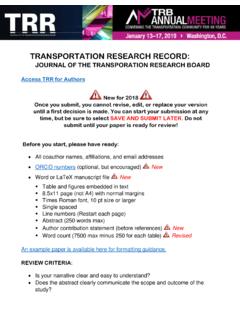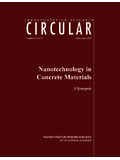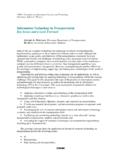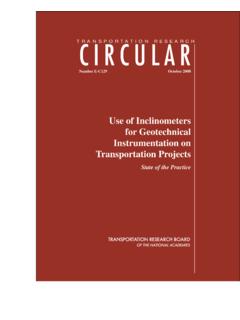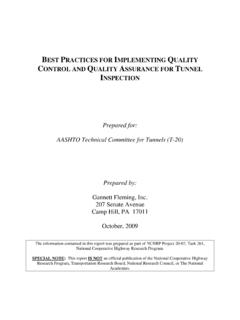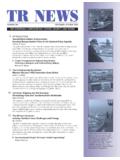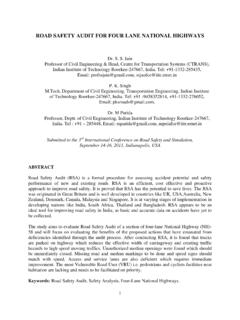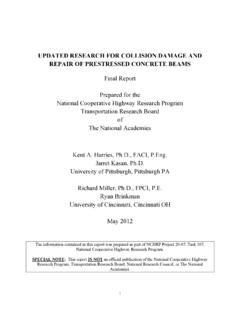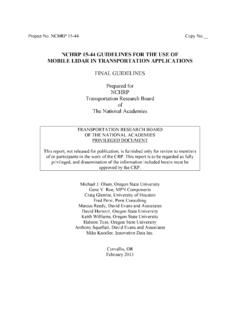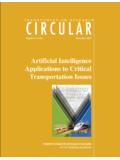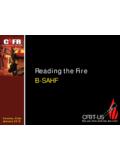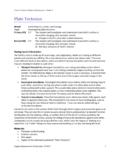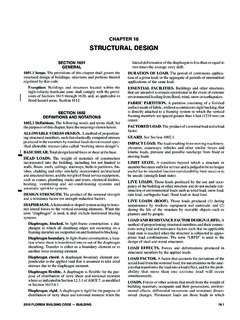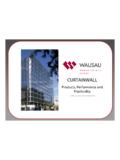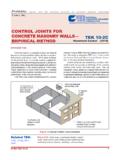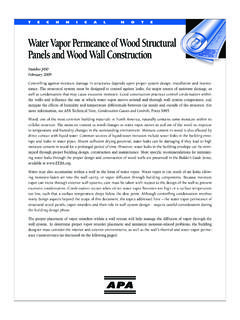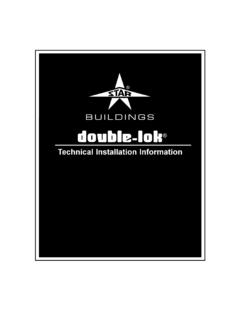Transcription of NCHRP 25-25/Task 72 - Transportation Research Board
1 NCHRP 25-25/Task 72. CURRENT PRACTICES TO ADDRESS. CONSTRUCTION VIBRATION AND. POTENTIAL EFFECTS TO HISTORIC BUILDINGS. ADJACENT TO. Transportation PROJECTS. Prepared by: Wilson, Ihrig & Associates, Inc., ICF International, and Simpson, Gumpertz & Heger, Inc. September 2012. The information contained in this report is part of NCHRP Project 25-25, task 72 National Cooperative Highway Research Program. SPECIAL NOTE: This report IS NOT an official publication of the National Cooperative Highway Research Program, Transportation Research Board , National Research Council, or The National Academies.
2 I NCHRP 25-25 ( task 72 ). Acknowledgements This study, Project 25-25 ( task 72 ), Construction Practices to Address Construction Vibration and Potential Effects on Historic Buildings Adjacent to Transportation Projects, was conducted with funding provided through the National Cooperative Highway Research Program ( NCHRP ). Annual voluntary contributions from state departments of Transportation support the NCHRP . Project 25-25 ( task 72 ) is intended to fund quick response studies that are of interest to the highway design and construction community. Richard A.
3 Carman, , (Principal Investigator) of Wilson, Ihrig & Associates, Inc. prepared this report with support from David Buehler, and Stephen Mikesell of ICF. International, and Carolyn L. Searls, of Simpson, Gumpertz & Heger. Deborah A. Jue and Ani S. Toncheva of Wilson, Ihrig & Associates and Edward Yarbrough and Eva Hsu of ICF. International also contributed to the project. Technical oversight and guidance was provided to this Research team by a panel composed of members from state departments of Transportation and a private consulting firm: Dr. Gail Anne D'Avino, Georgia DOT.
4 Mr. Karel Cubick, MS Consultants Ms. Joyce McKay, New Hampshire DOT. Mr. Robert S. Newbery, Wisconsin DOT. Mr. Antony F Opperman, Virginia DOT. Mr. Mario Sanchez, Texas DOT. Mr. Timothy V. Sexton, Washington DOT. Mr. John Underwood, Mississippi DOT. Ms. Mary Ann Naber, Federal Highway Administration Ms. Stephanie Stoermer, Federal Highway Administration Ms. Elizabeth Zelasko Patel, Federal Transit Administration Nanda Srinivasan, NCHRP Senior Program Officer, managed the project. Disclaimer The opinions and conclusions expressed or implied are those of the Research agency that performed the Research and are not necessarily those of the Transportation Research Board or its sponsoring agencies.
5 This report has not been reviewed or accepted by the Transportation Research Board Executive Committee or the Governing Board of the National Research Council. Instructions to Panel Members This project is being conducted under NCHRP Project 25-25 ( task 72 ), Construction Practices to Address Construction Vibration and Potential Effects on Historic Buildings Adjacent to Transportation Projects. The report will not go through the usual rigorous review process established and monitored by the Transportation Research Board Executive Committee or the Governing Board of the National Research Council, and should not be described as a TRB.
6 Report. It should be described as a contractor's report conducted with funding provided through National Cooperative Highway Research Program Project 25-25 ( task 72 ). NOTE: The Transportation Research Board of the National Academies, the National Research Council, the Federal Highway Administration, the American Association of State Highway and Transportation Officials, and the individual states participating in the National Cooperative Highway Research Program do not endorse products or manufacturers. Trade or manufacturers'. names appear herein solely because they are considered essential to the object of this report.
7 Ii NCHRP 25-25 ( task 72 ). Table of Contents 1. INTRODUCTION .. 1 2. BACKGROUND ON VIBRATION AND DAMAGE .. 1 Terminology .. 1 Construction Activity .. 2 Vibration Propagation .. 2 Building Response and 2 Building Settlement .. 3 3. SECTION 106 PROCESS .. 3 Section 106 and Vibration .. 3 The Section 106 Process in General .. 3 Initiating the Process .. 4 Identifying the Area of Potential Effects and Historic Resources .. 4 Assessing Effects .. 4 Resolving Adverse Effects .. 5 Section 106 as it Applies to Highway Construction Vibration .. 6 4. LITERATURE REVIEW.
8 6 Vibration Criteria .. 8 Current Practices .. 10 Procedures .. 10 Human Perception of Vibration .. 10 Summary .. 12 5. Transportation AGENCY SURVEY .. 13 Survey Response .. 14 Follow-Up Calls to Survey Respondents .. 14 6. CASE 15 Case Study #1: Sacramento Railyards Central Shops (Carman, et al.) .. 16 Case Study #2: Cypress Lawn Cemetery Entrance Archway and de la Monta a Mausoleum .. 18 Case Study #3: Gipfel Brewery Building, Milwaukee (HNTB Corporation and Wilson, Ihrig and Associates) .. 21 Case Study #4: Fraunces Historic District, New York City (Esrig and Ciancia).
9 23 Case Study #5: Fort Point San Francisco .. 24 Case Study #6: Historic District, New York City (Hammarberg, et al.) .. 26 Case Study #7: Presidio Buildings Doyle Drive, San Francisco (ICF International) 27 iii NCHRP 25-25 ( task 72 ). 7. RECOMMENDATIONS .. 30 Assessment Approach .. 30 Research and Approach to Disseminate Research Findings .. 31 8. CONCLUSION .. 31 9. REFERENCES .. 32 Appendices Appendix A. Literature Review Appendix B. Agency Survey Appendix C. Analysis Flow Chart Tables Table 1. Vibration Source Levels for Construction Equipment.
10 9. Table 2. Vibration Source Levels for Construction Equipment .. 30. Figures Figure 1. Typical Vibration Amplitudes and Thresholds .. 12. Figure 2. Car Shop within the Sacramento Railyards Central Shops Historic District 17. Figure 3. Cypress Lawn Cemetery Grand Gateway .. 19. Figure 4. Cypress Lawn Cemetery de la Monta a Mausoleum .. 20. Figure 5. Gipfel Brewery building being moved .. 23. Figure 6. Fraunces Tavern.. 23. Figure 7. Fort Point and Golden Gate Bridge .. 25. Figure 8. Buildings at the Presidio .. 28. iv NCHRP 25-25 ( task 72 ). Acronyms and Abbreviations AASHTO American Association of State Highway and Transportation Officials ACHP Advisory Council on Historic Preservation ADC40 Committee on Transportation Noise and Vibration APE Area of Potential effect APTA American Public Transit Association BART Bay Area Rapid Transit BETP Built Environment Treatment Plan Caltrans California Department of Transportation CFR Code of Federal Regulation CIDH cast-in-drilled-hole DOTs Departments of Transportation EIS Environmental Impact Statement FHWA Federal Highway Administration
